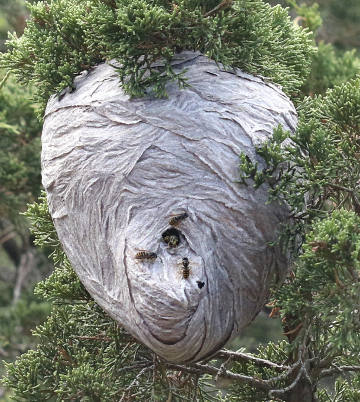Village News

PHOTO COURTESY OF GARRY KESSLER
Wasp nest with yellowjackets
August 21, 2020, Page A9
NATURE NOTES
By Annie Reid
Westborough Community Land Trust
Amazing wasp nests
Have you ever been surprised at this time of year to spot a large, gray wasp nest hanging in a tree or shrub out in the woods, complete with buzzing insects coming and going? It could even be in your yard or on a building. Or perhaps you’ve noticed such a nest in fall or winter when all was quiet.
Who are the builders of these large hanging nests? Often called wasps, they are certain kinds, or species, of yellowjacket. Two examples are the common aerial yellowjacket (Dolichovespula arenaria, also called the common yellow hornet), colored yellow and black, and the bald-faced hornet (Dolichovespula maculata), colored white and black. Certain other species of yellowjacket nest mainly in the ground or in hollow trees or walls. And species known as paper wasps, or umbrella wasps, make much smaller, simpler nests that hang from branches or the eaves of a building.
All construct their nests of a papery pulp that they make by collecting wood fibers, chewing them to mix the cellulose with their saliva, spreading the pulp with their jaws and legs, and allowing it to dry. Also mixed in are chemicals similar to some in the covering on the yellowjackets’ own bodies. These chemicals enable the yellowjackets to recognize their own nest and their nest-mates.
What’s inside the football-sized hanging nest? It has two to four tiers of hexagonal cells, where the young develop from egg to larva to adult. The whole nest has a many-layered papery covering that protects and insulates it.
How do mere insects manage to create such large, complex nests? The answer is that these yellowjackets are social insects that work together in organized ways. These species are among the most organized of social insects. They have a division of labor (workers that don’t reproduce and other adults that do reproduce), cooperative care of the young (by workers), and overlapping adult generations (queen and adult offspring).
The large, busy yellowjacket colony that lives in a nest today will be gone before next year. All will die in fall and winter as food and temperatures diminish, except for new queens that leave to overwinter in leaf litter or outdoor crevices.
The colony itself has a life cycle. A new colony starts in spring, when a yellowjacket queen that mated in the fall comes out of hibernation. This new queen finds a new nest site and builds a few cells, lays fertilized eggs in them, and feeds and cares for developing larvae until they mature into sterile female workers. After that, the queen mainly lays eggs, while the workers feed and care for developing young (more workers), enlarge the nest, forage and hunt, and defend the nest.
The colony and nest grow until mid-summer. At that time, some eggs yield adults that can reproduce: queens and males. This change in how larvae develop may be influenced by hormone-like pheromones that the original queen gives off, and by the quality and quantity of food fed to the larvae. Eventually the social organization breaks down. In New England, the colony doesn’t survive the winter.
Yellowjackets can sting multiple times and are most aggressive in the vicinity of the nest, which they defend, so keep your distance. Lone yellowjackets that you find away from the nest are less likely to be aggressive, so resist the urge to bat at them.
What good are yellowjackets? They’re among the predators of the insect world because they need protein to feed their young. Like other wasps, they hunt insects, such as flies and caterpillars, including some that humans regard as pests. Yellowjackets also pollinate as they feed on honey.
If you see a wasp nest, enjoy understanding a bit about the wasps’ world. And realize that, amazingly, many other insects have a complex social organization similar to that of these yellowjackets. Think of bees, some other wasps, ants, and all termites. Even some shrimp and a couple of rodents – the naked mole rats (Heterocephalus glaber) and Damaraland mole rats (Fukomys damarensis) of Africa – also have a similar social organization.